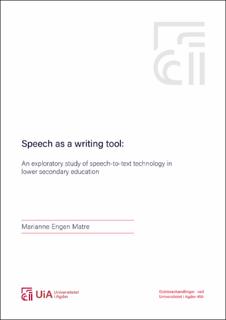| dc.contributor.advisor | Cameron, David Lansing | |
| dc.contributor.advisor | Wengelin, Åsa | |
| dc.contributor.author | Matre, Marianne Engen | |
| dc.date.accessioned | 2024-01-24T13:56:29Z | |
| dc.date.available | 2024-01-24T13:56:29Z | |
| dc.date.created | 2024-01-02T11:10:22Z | |
| dc.date.issued | 2024 | |
| dc.identifier.citation | Matre, M. E. (2024). Speech as a writing tool : An exploratory study of speech-to-text technology in lower secondary education [Doctoral dissertation]. University of Agder. | en_US |
| dc.identifier.isbn | 978-82-8427-167-5 | |
| dc.identifier.issn | 1504-9272 | |
| dc.identifier.uri | https://hdl.handle.net/11250/3113616 | |
| dc.description.abstract | The aim of this project is to explore the potential of STT as a writing tool for lower secondary education pupils with writing difficulties. The project comprises three studies. Study 1 is a scoping review of empirical research on the use of STT among secondary pupils with learning difficulties published from January 2000 to April 2022. Study 2 explores teachers’ perspectives of STT as an inclusive approach in secondary education through focus group interviews. Study 3 explores the use of STT as a writing modality through analyses of screen recordings and interviews with pupils with low writing achievement. The results of Study 1 indicate that very little research has been conducted on the use of such technology for adolescents with learning difficulties at the secondary education level. The review identified eight peer-reviewed studies and five publications of grey literature. Areas of interest include five topics: writing-related skills, text assessment, writing processes, accuracy of the technology and participants’ experiences. The findings further indicate that writing performance among pupils with learning difficulties is improved when using STT and that parents, teachers and pupils report positive experiences with using the technology. The results from Study 2 regarding teachers’ experiences of STT as an inclusive approach reveal that the implementation of STT technology challenges different aspects of inclusion. Furthermore, teachers primarily considered STT an assistive technology that is useful for pupils with writing difficulties. Yet, they also reported that the technology offers opportunities for all pupils to participate in collaborative writing tasks, discuss norms for formal and informal languages and produce first drafts without having to worry about spelling. In addition, whilst STT provides academic opportunities for most learners, it is also described as a disruptive and embarrassing element in a whole-class environment. Finally, the results from Study 3 reveal that pupils with low writing achievement could not rely on STT to be 100% accurate and to provide correct orthography and syntax in Norwegian. Such findings suggest that technological issues must be addressed and that sufficient practice is necessary before STT can be implemented as a truly beneficial tool for adolescents with low writing achievement within the context of Norwegian secondary education. | en_US |
| dc.language.iso | eng | en_US |
| dc.publisher | University of Agder | en_US |
| dc.relation.ispartofseries | Doctoral Dissertations at the University of Agder; no. 450 | |
| dc.relation.haspart | Paper I: Matre, M. E. & Cameron, D. L. (2022). A scoping review on the use of speech-to-text technology for adolescents with learning difficulties in secondary education. Disability and Rehabilitation: Assistive Technology. https://doi.org/10.1080/17483107.2022.2149865. Published version. Full-text is available in AURA as a separate file: https://hdl.handle.net/11250/3043118. | en_US |
| dc.relation.haspart | Paper II: Matre, M. E. (2022). Speech-to-Text Technology as an Inclusive Approach : Lower Secondary Teachers’ Experiences. Nordisk tidsskrift for pedagogikk og kritikk, 8, 233-247. https://doi.org/10.23865/ntpk.v8.3436. Published version. Full-text is available in AURA as a separate file: https://hdl.handle.net/11250/3022539. | en_US |
| dc.relation.haspart | Paper III: Matre, M. E. (Forthcoming). An Exploratory Study on the use of Speech-to-Text Technology as a Writing Modality for Pupils With low Writing Achievement in Norwegian Lower Secondary Education. Nordic Journal of Literacy Research. Submitted version. Full-text is not available in AURA as a separate file. | en_US |
| dc.rights | Attribution-NonCommercial-NoDerivatives 4.0 Internasjonal | * |
| dc.rights.uri | http://creativecommons.org/licenses/by-nc-nd/4.0/deed.no | * |
| dc.title | Speech as a writing tool : An exploratory study of speech-to-text technology in lower secondary education | en_US |
| dc.type | Doctoral thesis | en_US |
| dc.description.version | publishedVersion | en_US |
| dc.rights.holder | © 2024 Marianne Engen Matre | en_US |
| dc.subject.nsi | VDP::Samfunnsvitenskap: 200::Pedagogiske fag: 280 | en_US |
| dc.source.pagenumber | 170 | en_US |
| dc.source.issue | 450 | en_US |
| dc.identifier.cristin | 2218754 | |



